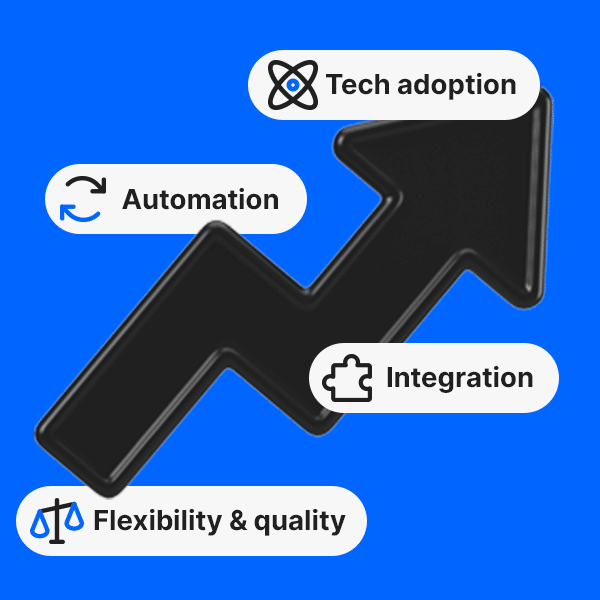A global payroll strategy is a core element of international expansion and growth for any midsize business. However, all too often, it’s still approached as little more than a technology upgrade, leaving the organizational impact on the wider business overlooked.
This means that making the right decisions on payroll transformation is about so much more than just choosing the right payroll software: it demands early alignment, robust governance and a strategic approach. We’ll explore how that works and what success looks like from a practical standpoint.
Why global payroll is more than just a tech upgrade
Expanding internationally means having to deal with many different countries with their own sets of payroll processes, tax laws and compliance regulations simultaneously, and midsize businesses often underestimate the work involved in keeping track of all of them as they change. Managing international payroll across new markets while ensuring adherence to local regulations and country-specific labor laws becomes increasingly complex.
This becomes even more difficult when data is fragmented, which is a common issue for smaller and mid-size organizations. Often, they expand into new countries and look for local payroll solutions which are easy and inexpensive to set up. However, when many of these have been set up across different territories, a lack of integration and standardization makes payroll operations increasingly difficult to manage and scale. For companies facing time pressure and conflicting priorities across regions, this fragmentation can quickly become unmanageable and create significant inefficiencies in their payroll function.
At a human level, change management is also a critical consideration, as employees around the world need time and resources to become aligned with new systems, platforms and processes.
As an example of how this can go wrong, one organization came to CloudPay for help as they had missed a cut-off date for uploading key payroll data, meaning that the entire UK arm of their business had missed a payday. With CloudPay’s support, they were able to make an emergency advance payment to all 600 UK-based employees on the same day. However, this had to be deducted from the following month’s pay, creating uncertainty for the workforce and additional work for the payroll team.
This situation highlights exactly why robust preparation and reliable payroll infrastructure are essential. Without proper systems in place, even small errors can escalate into business-critical emergencies and create significant compliance risks.
How to build your foundation: Alignment, governance, and realistic planning
Before implementing any technology, successful payroll transformation requires solid foundations. This means getting all stakeholders aligned and establishing realistic project governance from the start. This is achieved through three key initiatives:
Engage in-country teams from day one
Direct communication should be established between the global payroll provider and every in-country payroll team. This means they don’t have to wait for any potentially urgent comms to be channeled back and forth through a centralized support team. It also helps ensure that local regulations, tax regulations, and payroll compliance requirements are made clear for all parties, and that cultural nuances are respected throughout the transformation process.
Create a shared vision and clear governance
Not only should there be a clear plan for how the transformation will proceed, but that plan should be shared far beyond the payroll team and throughout the wider organization. This is so other stakeholders can become invested in the process, and help facilitate wider change across training, communication, and meeting wider business needs. It also helps keep everyone aligned, and ensures everyone is working towards the same agreed objectives, ultimately enabling more effective decision-making across the organization.
Build a realistic rollout roadmap
Having the building blocks from the above two points in place allows a roadmap to be built with realistic timeframes and proper scalability considerations. Given that entity set-up can take up to three months in some countries, with onboarding to follow after that, it generally means that road-mapping should start at least a year before any existing country contracts end — and well in advance of any launch of expansion plans.
Aligning your tech capabilities with global payroll demands
After those foundations have been well-established and agreed, then technology choices can be explored. But this evaluation process should extend beyond basic functionality, to operational capabilities that ensure long-term success. From our experience, we recommend:
1. Prioritize validation and issue management over features
This starts by asking lots of questions of prospective vendors, including how issues are managed, recorded, tracked and resolved. Ideally, this will be defined at a global level, and therefore will be well-supported by whatever platform is chosen.
2. Understand automation’s true requirements
A good vendor will be able to clearly articulate all the areas of a payroll lifecycle where automation can be beneficial. This includes the triggers that bring automation into the process, the actions that the automation will complete, and the conditions that the automation checks before starting its processes. And just as importantly, how to maintain data and performance quality, including how and where humans are brought back into the loop as appropriate.
3. Make sure you can leverage analytics for strategic value
Analytics is more important for payroll than it’s ever been, as it can be used to quantify and benchmark success — however ‘success’ is defined at the start of the planning process. Embedding the inclusion of analytics at the outset means that conversations about success can always be data-driven, and never reliant on assumptions or anecdotal evidence. In turn, being able to rely on hard evidence will help payroll have a larger, more authoritative voice across the wider business.





